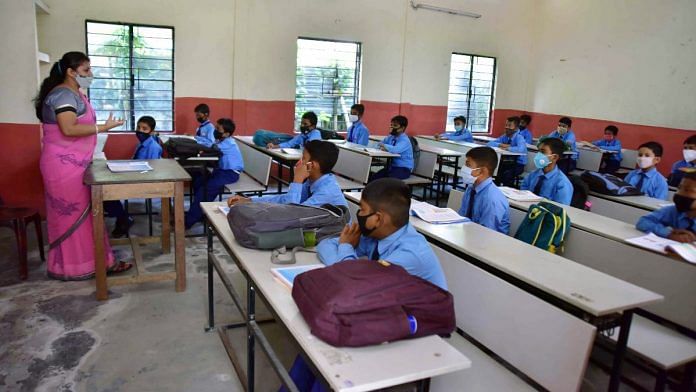New Delhi: Just 16 states and union territories across the country provide admission to students from disadvantaged groups and Economically Weaker Sections (EWS) in private unaided schools without charging a fee, a report by the National Commission for Protection of Child Rights (NCPCR) has found.
The NCPCR has prepared the report on the implementation of Section 12 (1)(c) of the Right of Children to Free and Compulsory Education Act, 2009, better known as the Right to Education (RTE) Act. Under this section, private unaided schools are meant to reserve 25 per cent of seats for children from disadvantaged groups/weaker sections without any fee.
Assam, Bihar, Chandigarh, Chhattisgarh, Delhi, Gujarat, Himachal Pradesh, Karnataka, Madhya Pradesh, Maharashtra, Odisha, Rajasthan, Tamil Nadu, Uttarakhand, Uttar Pradesh and Jharkhand are the states and UTs that have implemented the section, said the report, which has been accessed by ThePrint.
Andaman and Nicobar Islands, Andhra Pradesh, Arunachal Pradesh, Dadra and Nagar Haveli, Daman and Diu, Goa, Haryana, Jammu and Kashmir, Ladakh, Kerala, Lakshadweep, Manipur, Nagaland, Meghalaya, Mizoram, Puducherry, Punjab, Sikkim, Telangana, Tripura and West Bengal haven’t implemented the rule.
Under the RTE Act, children in the age group of 6-14 are guaranteed free and compulsory education in India. However, the report said the enrolment from weaker sections is quite low.
“The enrolment of children under DG/EWS category is just 5.4 per cent of the total enrolment, which should be at least 25 per cent as per the RTE Act, 2009,” the report said.
The report cited data from the 2018-19 academic year, but NCPCR officials told ThePrint that nothing has changed since.
The report was submitted to the Ministry of Education (MoE) in July this year, along with freshly prescribed Standard Operating Procedures (SOPs) for the implementation of the rule.
The ministry is studying the report and will issue instructions based on it, a senior official in the MoE told ThePrint on the condition of anonymity.
Also read: Not just CCTV & invigilators, CBSE will use data analytics to identify cheating in exams
NCPCR says Kerala worst, state govt points to ‘anomaly’
According to NCPCR chairperson Priyank Kanoongo, Kerala is the worst performing state in terms of implementing Section 12(1)(c).
“We are not even sure if they are following other provisions of the RTE properly and including Class 8 children under the free and compulsory education scheme. As far as we know, they are extending the scheme only till Class 7,” Kanoongo said.
However, the Kerala government denied these charges, saying there is an anomaly due to classification.
“EWS admission is implemented in the state, but I will still have to examine the intricacies (of the report) to understand in detail,” said A.P.M. Mohammad Hanish, Kerala’s Principal Secretary, General Education.
On allegations over the state’s non-inclusion of Class 8 students under the free and compulsory education provision, he said the “anomaly” arises as Kerala has considered Class 7 as the final stage of primary school “for a long time”. “Upper primary begins from 8th standard onwards,” he said.
What the SOP says
The SOP formulated by NCPCR for better implementation has defined the children who can be considered under disadvantaged groups and weaker sections.
Disadvantaged groups shall include children from Scheduled Castes, Scheduled Tribes, Other Backward Classes (non-creamy layer), denotified tribes and nomadic tribes, children with disabilities/special needs, children suffering from HIV/AIDS, children of martyred soldiers/Central Armed Police Forces personnel or those killed in the line of duty, and children of deprived communities such as traditional sex workers.
Weaker sections shall include children belonging to families/households that are registered under Antyodaya Anna Yojana, families/households included in the state’s Below Poverty Line list, and children belonging to such parents/guardians whose annual income is lower than the minimum limit prescribed by the appropriate government.
The SOP adds the death of father/mother/guardian, who is the earning member of the family, will result in child’s admission under the EWS category upon submission of requisite eligibility certificate.
The SOP also talks about how the scheme can be effectively implemented with the help and support of the media and community engagement initiatives.
“NGOs in the local area shall hold admission rallies, public announcements, and distribute pamphlets to raise awareness in the local area during the quarter when the admissions take place,” it says.
“The school shall display on its notice board all information with regards to admissions at an accessible place,” it adds.
(Edited by Amit Upadhyaya)
Also read: Here’s the secret ingredient to improve children’s learning ability in schools



